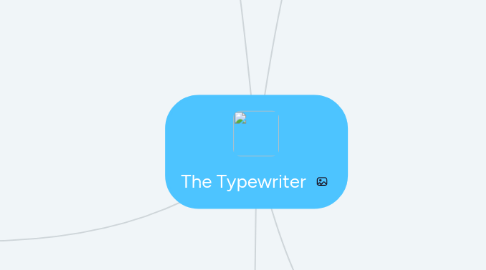
1. Original design
1.1. Block form
1.1.1. Made to be used on a desk
1.1.2. Heavy
1.1.3. fragile mechanisms
1.1.4. Individual letter stamps
1.2. metallic
1.2.1. Began to be decorated with flower designs
1.2.1.1. Marking product as a feminine object
1.2.2. customized
1.2.2.1. Size
1.2.2.2. materials
1.2.2.3. Professional vs Personal
1.2.3. durable material
1.3. Loud keystrokes
1.3.1. Loud ingenerals
1.4. Keyboard
1.4.1. Raised keys
1.4.1.1. Space around so nails wouldn't make contact with keys
1.4.1.2. Slightly depressed cup design to fit fingers
1.4.2. Original keyboard broke from used
1.4.2.1. Became Altered by women ability to type
1.4.2.1.1. QWERTY keyboard designed to keep up
1.4.2.2. August Dvorak
1.4.2.2.1. Dorvak Keyboard
2. Designers
2.1. Remington
2.1.1. Remingtion 1
2.1.1.1. uppercase only
2.1.2. Remmington 2
2.1.2.1. First to offer upper and lowercase
2.2. Wellington Parker Kidder
2.3. John Thomas Underwood
2.3.1. Bought rights to "Font-Strike"
2.3.1.1. US Navy ordered 250 in 1897
2.4. IBM
2.4.1. Later released the type ball
2.4.1.1. 2008
3. Modern Design
3.1. Computers
3.1.1. designs
3.1.1.1. sleek
3.1.1.2. narrow
3.1.1.2.1. keyboarders suitable for females and not males due to shoulder width and proper posture
3.1.1.3. lightweight
3.1.1.4. little mentions of power
3.1.2. Variations
3.1.2.1. Desktop
3.1.2.2. Laptop
3.1.2.3. Tablet
3.2. Keyboards
3.2.1. QWERTY
3.2.1.1. standard, nearly no variations
3.2.2. Only slightly raised keys
3.2.2.1. Still slightly depressed to fit fingers
3.2.3. Made to make less noise
3.2.4. No longer always attached
3.2.5. narrow unless made for gamind
3.2.5.1. gaming seen as male hobby
3.2.5.1.1. keyboards designed diffrently
3.3. Plastic usually
3.4. Still Customisable
3.5. Continued variations in professional vs personal
4. WW2
4.1. Lack of men at home, many fighting
4.1.1. Men no longer in offices or factories
4.1.1.1. Many open jobs
4.1.1.2. Factory work stagnated
4.1.1.3. Office work halted
4.2. Women allowed to work
4.2.1. Gender shift in workforce
4.2.1.1. Women worked in factories
4.2.1.1.1. Now in Offices
4.2.1.1.2. Image of Women improved
4.2.1.1.3. Helped lead into the suffragette movement
4.2.1.1.4. Female Professionals
4.2.1.1.5. pay raises offered to attract women
4.2.1.1.6. textile factories
4.2.2. Encouraged to take typing classes
4.2.2.1. Women encouraged to be in school
4.2.3. Education in typing now expected
4.2.3.1. Woman encouraged to seek post secondary instead of settling down
4.2.3.2. type classes remained until being replaced by computer class
4.2.3.3. classes near exclusively for females
4.2.3.3.1. Seen as a woman skill
5. Modern Impact
5.1. Gender roles in offices
5.1.1. Secretary 👩💼
5.1.2. Stenographers
5.1.3. Assistantships
5.2. keyboard size
5.2.1. Standard laptop vs Gaming
5.2.2. Based off of original models
5.2.2.1. Made to be comfortable for women
5.3. marketing
5.3.1. For Work
5.3.2. For gaming
5.3.3. Little human interaction
5.4. Media representation
5.4.1. The Office
5.4.1.1. Mentions typing speed
5.4.1.2. Derogatory beliefs
5.4.1.2.1. gendered position
5.4.1.2.2. "word secretary is belittling"
5.4.1.3. one male example(professional not temping)
5.4.1.3.1. made male effeminate
5.4.2. Suits
5.4.2.1. Assistant
5.4.3. Devil Wears Prada
5.4.3.1. Assistant/ secretary
